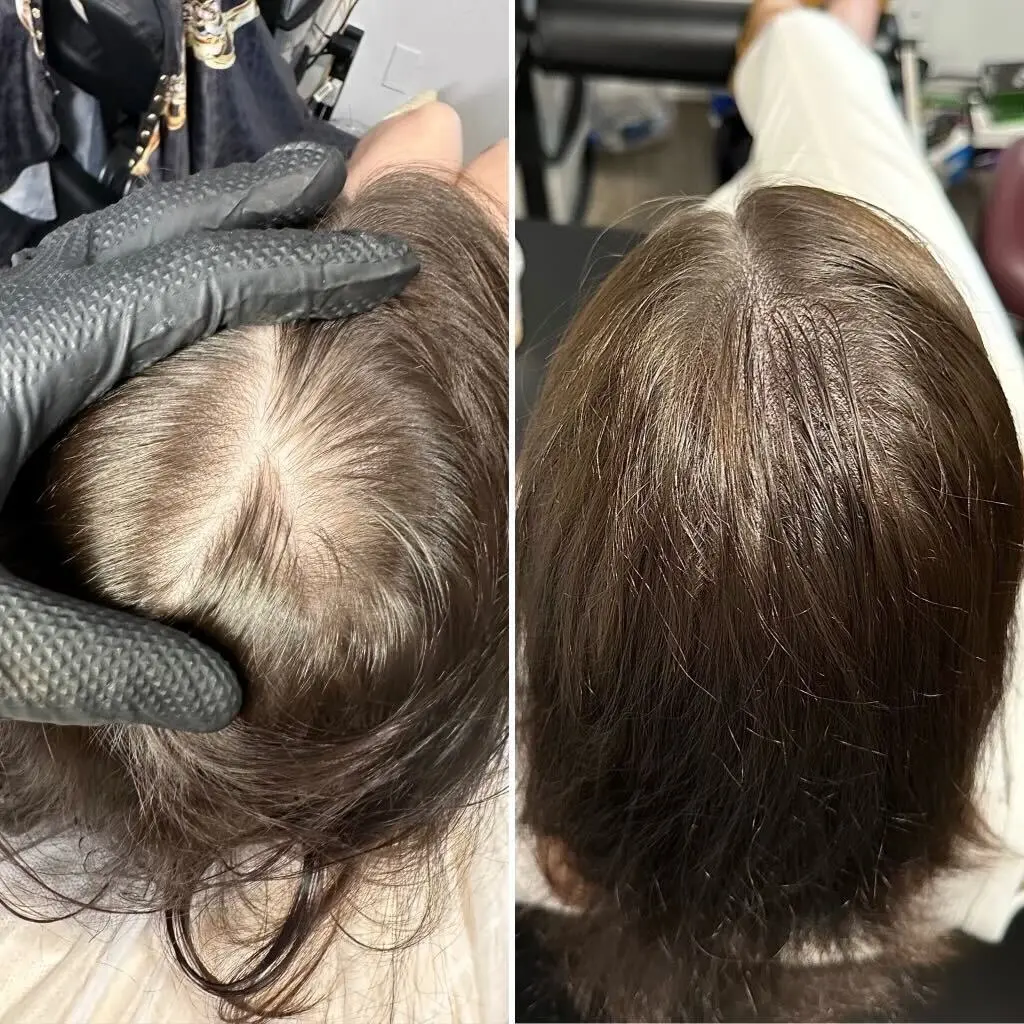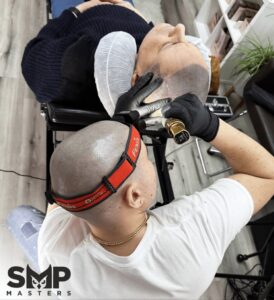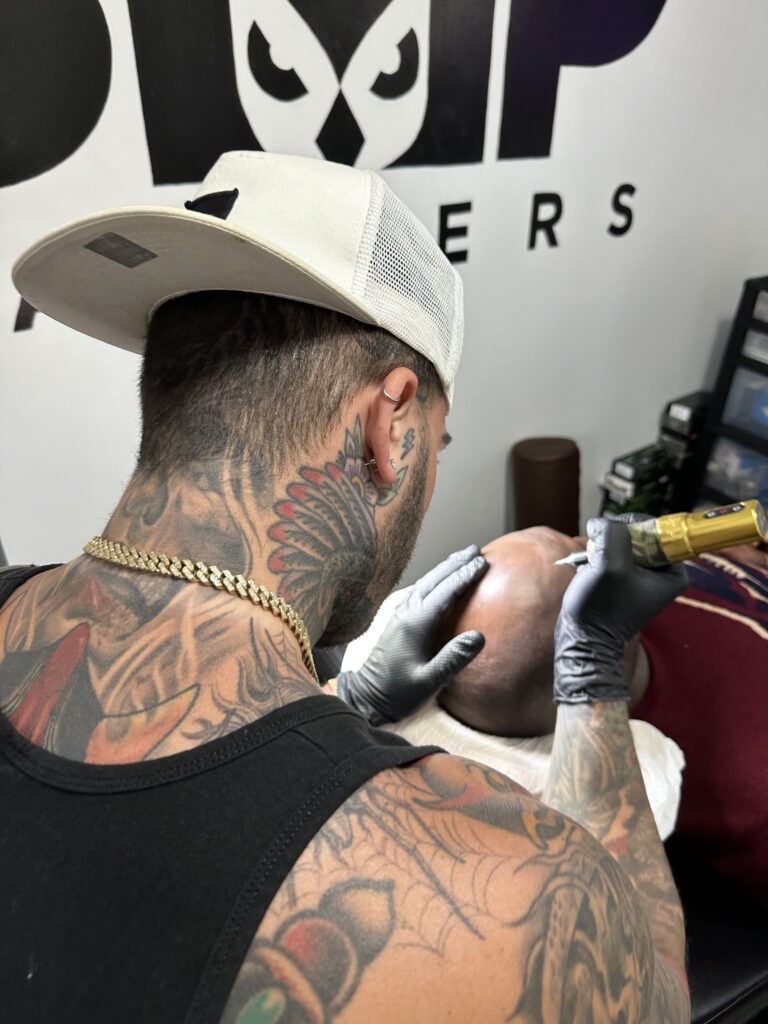Embarking on the journey to address hair loss with hair replacement options can often lead to mistakes that undermine the effectiveness of the treatment. At SMP Masters Scalp Micropigmentation, we specialize in providing top-tier solutions that steer clear of common pitfalls. Whether you’re considering the best hair tattoo clinic or exploring scalp micropigmentation in NYC, it’s crucial to make informed decisions to achieve the most natural and satisfactory results. Avoiding these common mistakes can significantly enhance your experience and ensure you attain the appearance you desire.
Our expertise as an SMP artist in New Jersey places us at the forefront of hair restoration technologies. Serving areas from Rahway NJ SMP to Newark NJ SMP, and even extending services to Elizabeth NJ SMP and SMP Marlboro NJ, we at SMP Masters are dedicated to delivering excellence in every procedure. Understanding the nuances of effective scalp micropigmentation and selecting a provider with proficient artists are key steps toward achieving a flawless look. Avoid the pitfalls of bad hair replacement by choosing trusted professionals who can provide guidance tailored to your individual needs.
What Is A Bad Hair Transplant? How To Deal With It
A bad hair transplant is typically characterized by poor aesthetic results that do not meet the expectations of the individual. This can include unnatural hairlines, patchy hair growth, visible scarring, or an overall unsatisfactory appearance that fails to blend seamlessly with the existing hair. Such issues often stem from outdated techniques, inexperienced surgeons, or improper planning and execution of the hair transplant procedure.

How to Deal with a Bad Hair Transplant
- Assessment by a Professional: The first step is to consult with a reputable hair transplant specialist who can assess the extent of the issues and suggest appropriate corrective measures.
- Waiting Period: It’s important to wait until the full results of the initial transplant are visible, which can take up to 12 months, as some concerns might resolve themselves as the hair grows in.
- Corrective Surgery: For many, corrective surgery by a qualified and experienced surgeon is necessary to revise the previous work, which might include redistribution or removal of poorly placed grafts, and creating a more natural-looking hairline.
- Scalp Micropigmentation: In cases where surgical correction is limited or not desired, scalp micropigmentation can be considered to camouflage scarring and add density to thinning areas.
- Medical Treatments: Utilizing medical treatments such as finasteride or minoxidil can help improve the density of hair around the transplant area, supporting the overall appearance.
- Legal Advice: If the bad hair transplant was due to negligence or misleading claims by a clinic or surgeon, seeking legal advice might be advisable to understand your rights and potential compensation.
It’s crucial for individuals considering hair transplant surgery to select their clinic and surgeon based on credentials, reviews, and a thorough consultation to discuss realistic outcomes and potential risks.
Why Do Hair Transplants Go Wrong?
Hair transplants can go wrong for a variety of reasons, often resulting in disappointment for those expecting transformative results. Understanding these reasons is crucial for anyone considering this type of procedure. Here’s why hair transplants might not always meet expectations, incorporating the specialized services and locations that might offer alternatives or solutions:
- Inadequate Experience or Training: When the procedure is performed by clinicians without the specific skills required, results can be unsatisfactory. This underscores the importance of choosing accredited facilities like the best hair tattoo clinic or a well-reviewed SMP clinic in New Jersey, where experienced professionals handle delicate procedures.
- Outdated Techniques: The use of outdated hair transplant techniques can lead to less natural-looking results. This is why facilities that offer cutting-edge solutions, such as SMP Masters in Manhattan or the SMP artist in Manhattan, are crucial for ensuring more refined and updated aesthetic outcomes.
- Poor Planning and Design: An unnatural hairline or uneven hair density results from poor planning. Consulting with experts at high-standard locations such as scalp micropigmentation NYC or micro scalp pigmentation New York City can help in getting a second opinion and designing a more satisfactory hairline.
- Post-Surgical Care Neglect: The failure to follow post-surgical care guidelines can lead to poor results or complications. Establishments like the SMP clinic in New Jersey often provide detailed aftercare instructions to their clients.
- Patient’s Health and Scalp Condition: The success of a hair transplant also depends on the patient’s health and the condition of the scalp. Clinics such as the SMP artist in New Jersey or SMP Freeport in Long Island can offer alternatives like scalp micropigmentation that are less dependent on these factors.
- Scarring: Some patients may experience significant scarring, which can be visible post-transplant. Innovative solutions such as scalp micro pigmentation in NY or SMP Huntington in Long Island can help camouflage these issues effectively.
By addressing these potential pitfalls, and possibly opting for alternative or complementary treatments such as those offered by SMP Long Beach in Long Island or hair tattoo specialist NYC, patients can achieve a more satisfying and aesthetically pleasing outcome. Always ensure that any treatment, whether it’s a hair transplant or scalp micropigmentation, is handled by accredited and skilled professionals to minimize the risk of dissatisfaction.

Can a Bad Hair Transplant be Fixed?
Yes, a bad hair transplant can often be fixed, but the approach depends on the specific issues encountered and the extent of the problem. Correcting a poor outcome generally involves a combination of strategies tailored to improve both the aesthetic and functional aspects of the initial transplant. Here’s how it can be done:
- Consultation with a Specialist: The first step is to consult with a highly skilled hair transplant surgeon or a dermatologist who specializes in hair restoration. They can assess the current state of your scalp, the viability of the hair follicles, and the overall aesthetics of the transplant.
- Corrective Hair Transplant Surgery: Depending on the initial results, another hair transplant may be necessary. This procedure would typically aim to add density, adjust the hairline, or redistribute grafts to create a more natural appearance. The surgeon might harvest additional follicles either from the scalp or other areas of the body if scalp donor hair is insufficient.
- Scalp Micropigmentation (SMP): For cases where further surgery is not advised or desired, SMP can be a viable alternative. This technique involves tattooing tiny dots on the scalp to mimic the look of short hair follicles, which can help camouflage scarring and increase the appearance of density.
- Medical Treatments: Medications like Minoxidil and Finasteride can be recommended to help strengthen existing hair and potentially improve the quality of the transplant area.
- Laser Therapy: Low-level laser therapy may be used to stimulate hair growth and enhance the health of transplanted follicles, improving the overall appearance.
- Camouflage Products: Temporary solutions such as hair fibers, sprays, or powders can be used to cover up any areas that lack density until a more permanent solution is viable.
Each case is unique, so it’s important for individuals to have realistic expectations and to discuss all possible options and outcomes with a qualified professional before proceeding with corrective measures.
How to Deal with a Bad Hair Transplant
Dealing with a bad hair transplant can be distressing, but there are several steps you can take to address the issue and improve the outcome. Here’s a step-by-step approach:
- Wait for Full Growth: Hair transplants take time to mature, and it’s important not to rush to judgment. Full results can take up to 12-18 months to be visible. During this period, the hair will go through various phases of shedding and growth.
- Consult a Reputable Specialist: If, after waiting, you are still unhappy with the results, consult a reputable hair restoration specialist. They can assess your scalp, the quality of the initial work, and discuss the potential for corrective options.
- Consider Corrective Surgery: If feasible, corrective surgery may be recommended. This can involve additional hair grafts to fill in thin areas, creating a more natural hairline, or correcting any visible scarring.
- Explore Scalp Micropigmentation (SMP): SMP can be an effective way to camouflage scars or areas where hair density is lacking. This non-invasive procedure uses microneedles to deposit pigment into the scalp, creating the appearance of a fuller head of hair.
- Medical Treatments: Ask about medical treatments such as Minoxidil or Finasteride, which can help improve the density of your existing hair and potentially enhance the overall appearance of the transplant.
- Laser Therapy: Low-level laser therapy is another option that can stimulate hair growth and improve the health of the scalp and transplanted hair.
- Use Camouflage Products: While permanent solutions are being considered, temporary camouflage products like hair fibers, concealers, or powders can be used to cover up less dense areas.
- Manage Expectations: Discuss with your doctor what is realistically achievable. Understanding the limitations of corrective procedures can help set realistic expectations and reduce disappointment.
- Legal Advice: If you believe that your bad hair transplant was the result of negligence or malpractice, consulting a legal professional might be advisable. They can provide guidance on whether you might be entitled to any form of compensation.
- Support Networks: Consider connecting with support groups where other individuals who have experienced similar issues share their stories and solutions. This can provide emotional support and practical advice on dealing with the situation.
Each step should be approached carefully and after thorough discussion with professionals who specialize in hair restoration. The goal is to find a solution that not only addresses the aesthetic concerns but also supports the overall health of your scalp.
Expert Consultation in Your Area
-
At SMP Masters Scalp Micropigmentation, we understand the unique challenges faced by individuals exploring hair replacement options. Whether you are in Rahway, Newark, or Marlboro NJ, our expert SMP artists are here to provide personalized consultations. We help you avoid common mistakes by tailoring our approach to your specific needs, ensuring you achieve the best possible results.
Leading Techniques and Advanced Technology
-
Leveraging advanced SMP techniques, our clinics across New Jersey, including Elizabeth NJ SMP and SMP Marlboro NJ, use state-of-the-art technology to deliver precise, natural-looking results. Avoid the pitfalls of outdated procedures and embrace the innovation that leads to success in scalp micropigmentation.
Satisfaction Guaranteed with Every Procedure
-
As the best hair tattoo clinic and SMP artist in New Jersey, our primary goal is your complete satisfaction. From the bustling streets of NYC to the serene shores of Long Beach in Long Island, our services are designed to meet the highest standards of quality and care, ensuring every client walks out feeling confident and pleased with their appearance.
Post-Treatment Support and Care
-
Our commitment to excellence extends beyond the treatment room. Clients from SMP New York, SMP Freeport in Long Island, and scalp micro in NY benefit from our comprehensive aftercare support. We guide you through the healing process, offer tips to maintain your new look, and provide follow-up care to ensure lasting results.
Conclusion
In conclusion, navigating the world of hair replacement requires careful consideration to avoid common pitfalls that lead to unsatisfactory outcomes. By choosing SMP Masters Scalp Micropigmentation, you’re partnering with a team of dedicated professionals committed to providing top-notch service and cutting-edge solutions in scalp micropigmentation. Whether you’re in Rahway, Elizabeth, Newark, or any of our other locations throughout New Jersey and New York, we are here to ensure that you avoid the top 5 most common mistakes in hair replacement. Our approach combines expert consultation, advanced techniques, guaranteed satisfaction, and comprehensive post-treatment care, setting you on a path to achieving not only a great look but also renewed confidence. Trust SMP Masters to deliver exceptional results that transform and transcend typical hair replacement challenges.


